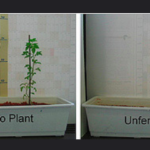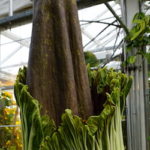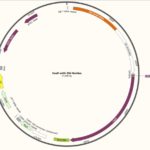Nathaniel Graham
Nat holds a PhD in Biology from the University of Missouri-Columbia and is currently Lead in Molecular Biology at Pairwise.
Articles by Nathaniel Graham
Because of the ease of performing controlled crosses, maize (or corn (Zea mays)), has been a staple of plant genetics research for decades. Barbara McClintock herself chose maize as her research organism for her Nobel Prize winning work. If you are looking to get involved but aren’t sure how to get good yields in the…
If you have ever had a home garden, you are probably familiar with the fact that adding a little fertilizer to a plant can really do wonders. This can also be the case in a lab greenhouse! The difference is that instead of adding a bit of the “blue stuff,” we try to be a…
A while back, one of our readers asked for a quick and easy and quick way to extract plasmids from transformed Agrobacterium tumefaciens cells. They pointed out that plasmid copy number is often low in Agrobacterium and that yield can be poor in alkaline base miniprep protocols. The short answer is that there is no…
If you have worked in a lab before, you probably think you are prepared to work anywhere. You’ve done the safety classes, know how to store the chemicals, even know how to work the chemical shower. Unfortunately, that doesn’t fully prepare you for greenhouse work. Greenhouses are a different kind of greenery-filled animal entirely, and…
Sometimes you know a project is going to be a pain before you even start it. For me, that is whenever I need to clone large (> 3 kb) or complex (e.g., a sequence with repeats) DNA fragments. Long and complex DNA fragments are more likely to create challenges during cloning. Such projects require extra care in just about…
I know what you are thinking, everything is made of cells, so how different can DNA extractions be in plants? The answer is… sort-of different. The overall concept is the same. Cell membranes are lysed, DNA is separated from other cell materials, washed a few times, and then resuspended in water or Tris-EDTA buffer (aka…
Running a pulsed field gel can be exciting. It isn’t often that you get to visualize such large pieces of DNA. However, it can also be extremely frustrating. It isn’t uncommon to wait 24 hours only to find out that your DNA was degraded before you started the run. Then, you have to start all…
At the heart of cloning are restriction enzymes. Restriction enzymes are a common tool in any molecular biology lab. Need to know how large your plasmid is? Cut it with a restriction enzyme. Need to chop your genomic DNA into smaller pieces for a southern hybridization or to prepare a library? Use a restriction enzyme.…
You have probably run a standard agarose gel hundreds of times. They are great for visualizing small DNA fragments up to 10 kb, but what if you want to examine really large pieces of DNA or even whole chromosomes? This is where pulsed field gel electrophoresis (PFGE) comes in! While the equipment required to run…
Restriction cloning, at its core, is quite simple. You simply cut the target vector and insert with the same enzymes, clean digested vector and insert up, ligate the two together, transform the ligated vector and insert into bacteria, and then screen. While getting each of the steps correct can be a bit of a hassle,…
Working in a lab can be stressful, there is so much to do, and so little time to do it that we often feel overwhelmed. Sometimes you come into the lab and there are 15 experiments that just need to be done, so you throw on some music and start doing a bunch of them…
One of the most exciting things about being a scientist is doing experiments that have never been done before. Unfortunately, this can also be one of the most daunting aspects of science. Read on to make taking on your next experiment less daunting.
While they may not be as in demand as when they were the basis of sequencing projects, bacterial artificial chromosomes (BACs) are still used for a wide variety of projects. Based off of the F origin of replication, BAC vectors can stably maintain up to 300 kb of sequence in a single plasmid, lending themselves…
For many, myself included, the idea of attending a large conference and talking to hundreds of new people can be terrifying. Often times there are people in attendance you may want to collaborate with, or that you see as possible future employers, and you really don’t want to make a bad first impression. Luckily, there…














